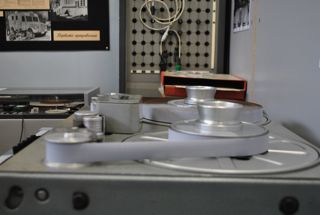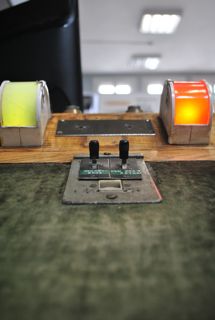Photos: Polina Spartyanova
Polina Spartyanova
"Is it a wonder that cultural countries compete in creating national radio broadcasting stations? Through them, they want to show themselves to the world, through them they bring education, welfare, morale to their people..." wrote in 1930 famous Bulgarian scholar and writer Asen Zlatarov, only a year after radio broadcasting in Bulgaria became a fact with the historic words, "Hello, hello, this is Radio Sofia". This is only a small part of the history of radio in Bulgaria presented at the Museum of Radio at the Faculty of Journalism and Mass Communication in Sofia. Although the Museum was opened just a year ago, new and valuable exhibits are being constantly added to its exhibition, thanks to numerous sponsors of exhibits and documents about the history of radio broadcasting in Bulgaria.
 Nowadays we take radio for granted in our daily lives and it can fit in one of the thousands of applications on our mobile phones, but for the people in the early decades of the past century it was a real phenomenon. At the Museum of Radio in Bulgaria we can go back in time and trace the evolution of radio receivers, decade after decade, from furniture part of the everyday lifestyle of the Bulgarians to simple devices filling in the spare time in their daily round.
Nowadays we take radio for granted in our daily lives and it can fit in one of the thousands of applications on our mobile phones, but for the people in the early decades of the past century it was a real phenomenon. At the Museum of Radio in Bulgaria we can go back in time and trace the evolution of radio receivers, decade after decade, from furniture part of the everyday lifestyle of the Bulgarians to simple devices filling in the spare time in their daily round.
The exhibition has over 500 receivers, some of which are over 100 years old and still working. The collection of receivers is mainly comprised of Bulgarian, Russian and German models. Visitors with a keen eye can make a comparison between the Bulgarian receiver "Tulan", which was produced in Bulgaria in the early 1930s, and the German "Blaupunkt", which was produced a few years later in Germany but has a striking resemblance to the first. However, one of the most impressive exhibits in the museum is a receiver that has been  preserved since World War II. The police at the time sealed it with red wax instead of with a "silencer" in order for it to receive only the frequencies of "Radio Sofia", without "entering the enemy radio fields." The technology used was quite simple – one obtained the radio set tuned in, by the authorities, to receive "Radio Sofia" station, with sealed knobs, thus preventing you from tuning it. However, this strict regulation could easily be circumvented by the thin hand of a child that could easily "creep" in the back cover and break the defence against "enemy radio stations".
preserved since World War II. The police at the time sealed it with red wax instead of with a "silencer" in order for it to receive only the frequencies of "Radio Sofia", without "entering the enemy radio fields." The technology used was quite simple – one obtained the radio set tuned in, by the authorities, to receive "Radio Sofia" station, with sealed knobs, thus preventing you from tuning it. However, this strict regulation could easily be circumvented by the thin hand of a child that could easily "creep" in the back cover and break the defence against "enemy radio stations".
At the unique Museum of Radio in Bulgaria, one can see not only unique exhibits from the start of the  Bulgarian radio broadcasting, but also listen to the authentic sound of the information and music broadcasts over the years. Here, the Golden Fund of the Faculty of Journalism and Mass Communication keeps recordings, photos and documents about the history of the first public radio station, "Home Radio", and of the state "Radio Sofia", from their inception in the 1930s to the late 1980s. The Museum keeps Bulgaria's only Swiss 4-track studio tape-recorder "Studer C- 37", which was put into operation in the Bulgarian National Radio nearly half a century ago and is still operational. The tape-recorder is fully incorporated in the operational analogue radio studio and it can run all the original tape records of pop music performed by some of the most popular Bulgarian pop singers like Lili Ivanova and Emil Dimitrov.
Bulgarian radio broadcasting, but also listen to the authentic sound of the information and music broadcasts over the years. Here, the Golden Fund of the Faculty of Journalism and Mass Communication keeps recordings, photos and documents about the history of the first public radio station, "Home Radio", and of the state "Radio Sofia", from their inception in the 1930s to the late 1980s. The Museum keeps Bulgaria's only Swiss 4-track studio tape-recorder "Studer C- 37", which was put into operation in the Bulgarian National Radio nearly half a century ago and is still operational. The tape-recorder is fully incorporated in the operational analogue radio studio and it can run all the original tape records of pop music performed by some of the most popular Bulgarian pop singers like Lili Ivanova and Emil Dimitrov.
 One of the major attractions for visitors at the Museum of Radio in Bulgaria is the operational analogue studio from the late 1960s. Everyone can sit behind the control panel of the radio studio and play the role of presenter or sound engineer for a day, and then take the memory of this saved on a disk. Thus, the Museum allows its visitors not only to learn about the history of radio in Bulgaria but also to become part of it. This is one of the few museums where touching is not prohibited and is even encouraged by the curators of the exhibition who open the showcases of the exhibits and allow each visitor to touch the first microphones of the Bulgarian "Home Radio" from 1930. Thus, the spirit of the radio will be "broadcast" in the future from hand to hand and from generation to generation.
One of the major attractions for visitors at the Museum of Radio in Bulgaria is the operational analogue studio from the late 1960s. Everyone can sit behind the control panel of the radio studio and play the role of presenter or sound engineer for a day, and then take the memory of this saved on a disk. Thus, the Museum allows its visitors not only to learn about the history of radio in Bulgaria but also to become part of it. This is one of the few museums where touching is not prohibited and is even encouraged by the curators of the exhibition who open the showcases of the exhibits and allow each visitor to touch the first microphones of the Bulgarian "Home Radio" from 1930. Thus, the spirit of the radio will be "broadcast" in the future from hand to hand and from generation to generation.